Journal No. 3 The “final mile” of the Climate Shelters project: communication, evaluation and replication
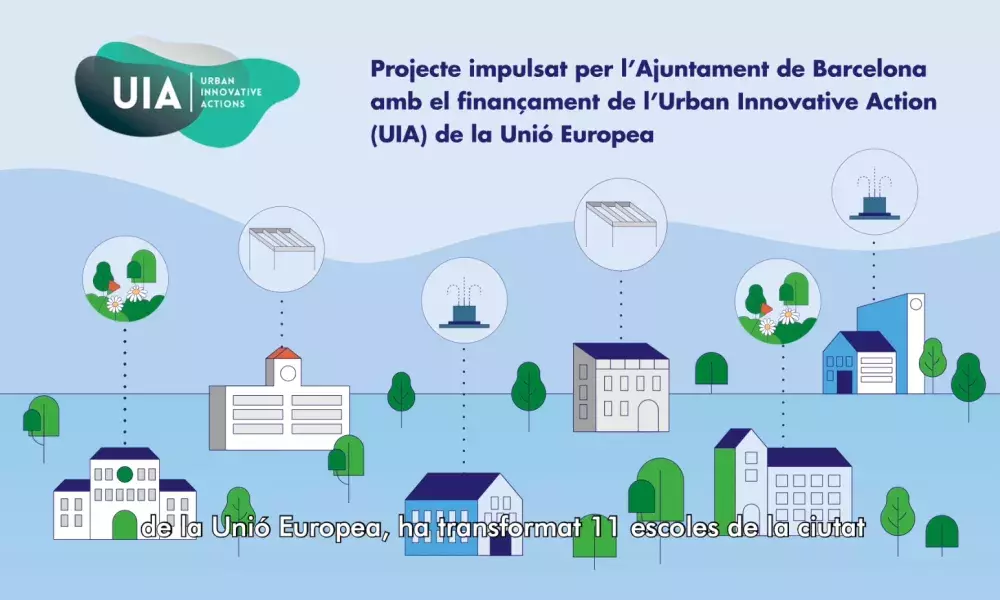
1.Executive summary
The project has overall managed to overcome the covid-19 complications and fulfill its milestones according to the schedule. In particular, the transformation of the eleven selected schools to Climate Shelters was completed as early as October 2020, whereas upscaling was initiated in 2021 through the integration of the project to the “Let’s transform our school yard” program of the City Council of Barcelona. Some communication activities were postponed due to restrictions for events with physical presence; on the contrary, the re-operation of the schools supported the exploitation of the technical solutions by the school community. Finally, the impact of the project on such sectors as environment, well-being and health is at present under evaluation.
The Journal (the 3rd for the project) aims to provide an overview of the progress of the Climate Shelters project, with emphasis given to the progress made in operational challenges: (a) communication, (b) evaluation and monitoring, and (c) upscaling. Finally, the challenges for the remaining period towards the conclusion of the project (October 2022) are also described.
The project has overall managed to overcome the covid-19 complications and fulfill its milestones according to the schedule. In particular, the transformation of the eleven selected schools to Climate Shelters was completed as early as October 2020, whereas upscaling was initiated in 2021 through the integration of the project to the “Let’s transform our school yard” program of the City Council of Barcelona. Some communication activities were postponed due to restrictions for events with physical presence; on the contrary, the re-operation of the schools supported the exploitation of the technical solutions by the school community. Finally, the impact of the project on such sectors as environment, well-being and health is at present under evaluation.
The Journal (the 3rd for the project) aims to provide an overview of the progress of the Climate Shelters project, with emphasis given to the progress made in operational challenges: (a) communication, (b) evaluation and monitoring, and (c) upscaling. Finally, the challenges for the remaining period towards the conclusion of the project (October 2022) are also described.
2. The Climate Shelters project at a glance
Barcelona’s answer to overheating includes the innovative pilot project to adapt schools to Climate Change, with the aim to develop a network of Climate Shelters around the city. The project has a duration of 3 years and is supported by the Urban Innovation Actions (UIA) of the European Commission.
The Climate Shelters project reflects considerable innovation as locally differentiated blue, green and grey technical solutions were implemented to eleven schools, following a co-creation participatory process. Climate Shelters are also open to the city residents and visitors, acting as cooling spots in the event of excessive heat or heat waves. The timeline of the project is presented in Figure 1; at present state, the project has reached Steps 6 and 7.
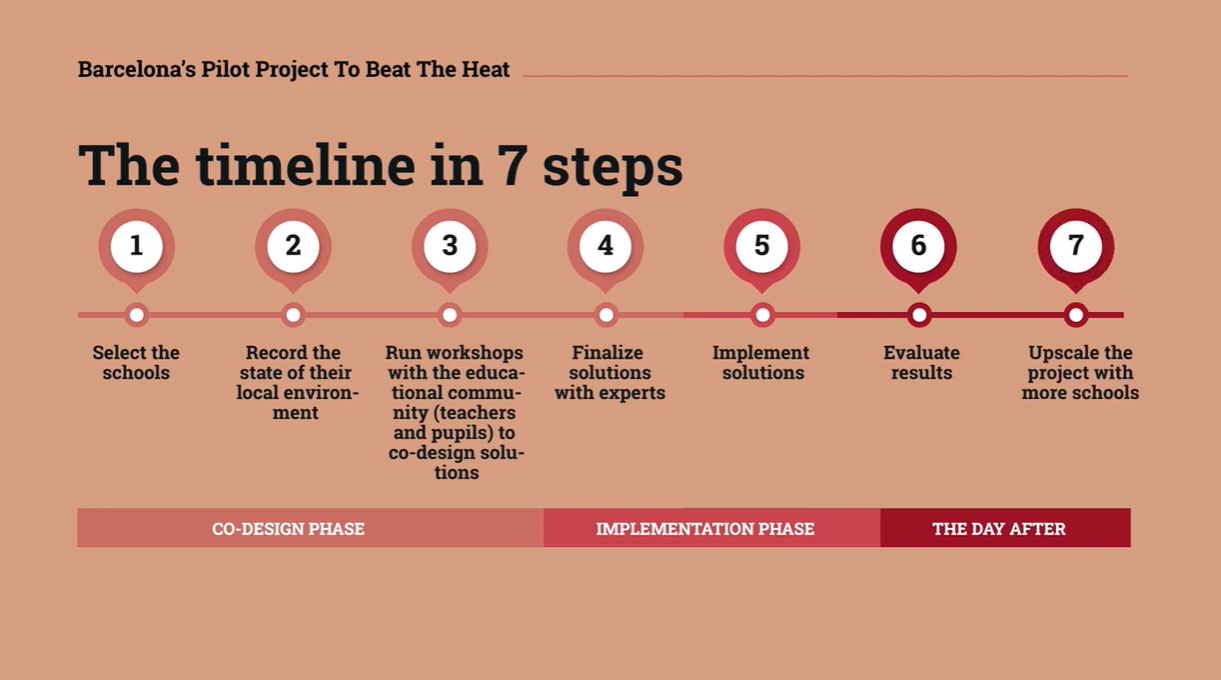
Fig 1. The timeline of the Climate Shelters project.
In particular, the work carried out at the selected schools refers to:
- Blue infrastructure: inclusion of points providing water, such as drinking fountains or unique places for children to play with water.
- Green infrastructure: more green space, improvements in vegetation and the creation of shade with green walls, more garden space, trees, green pergolas and fencing.
- Grey infrastructure: adaptation of buildings to improve insulation, with canopies, awnings, protection for façades and cross ventilation.
The creation of the Climate Shelters enabled 1,000 square meters of natural space to be regained, with vegetation in playgrounds and the creation of 2,213 square meters of new shade using pergolas and awnings. In addition, 74 trees were planted and 26 new water sources installed.
Barcelona’s answer to overheating includes the innovative pilot project to adapt schools to Climate Change, with the aim to develop a network of Climate Shelters around the city. The project has a duration of 3 years and is supported by the Urban Innovation Actions (UIA) of the European Commission.
The Climate Shelters project reflects considerable innovation as locally differentiated blue, green and grey technical solutions were implemented to eleven schools, following a co-creation participatory process. Climate Shelters are also open to the city residents and visitors, acting as cooling spots in the event of excessive heat or heat waves. The timeline of the project is presented in Figure 1; at present state, the project has reached Steps 6 and 7.

Fig 1. The timeline of the Climate Shelters project.
In particular, the work carried out at the selected schools refers to:
- Blue infrastructure: inclusion of points providing water, such as drinking fountains or unique places for children to play with water.
- Green infrastructure: more green space, improvements in vegetation and the creation of shade with green walls, more garden space, trees, green pergolas and fencing.
- Grey infrastructure: adaptation of buildings to improve insulation, with canopies, awnings, protection for façades and cross ventilation.
The creation of the Climate Shelters enabled 1,000 square meters of natural space to be regained, with vegetation in playgrounds and the creation of 2,213 square meters of new shade using pergolas and awnings. In addition, 74 trees were planted and 26 new water sources installed.
3. Overview of the operational challenges
There is strong political support to the project and its continuation.
The early preparedness of the City of Barcelona with respect to climate change adaptation, facilitated the smooth implementation of the Climate Shelters project as well as to its integration to the city’s climate actions.
The continuation of the project is supervised by the Barcelona Consortium of Education (CEB).
CEB managed to organize the procurement process and conclude the interventions per school in a timely manner.
The maintenance plan for the Climate Shelters has been developed and is under implementation by CEB.
The Climate Shelters project achieved a solid cross departmental collaboration and working.
A pending challenge is to sustain the cross departmental working in the upscaling phase of the project.
A thorough co-creation participatory process was promoted and was closely followed at all stages of the project.
The 4th and concluding participatory process has been completed at all schools, with positive assessments by teachers and students on the transformation of the schools to Climate Shelters.
The participatory process of the Climate Shelters project is an excellent showcase of urban governance with and for the citizens, namely decision making as close as possible to the citizen, open deliberations and finally co-creation of technical solutions.
Performance Indicators were defined for the periodic evaluation of the results of the Climate Shelters project.
A sophisticated evaluation of the project's results is undergoing, in terms of the impact to environment, well-being and health.
Preliminary findings demonstrate the potential of the project to ameliorate heat in the school building and yard and overall improve well-being in the schools' environment.
A set of videos (on the project and its results, on the methodology and the pedagogical approach applied) have been developed and widely distributed over the network and social media.
Videos per participating school were also prepared in support of developing a sense of ownership of the project.
The communication of the project's results to local communities as far as the impacts to environment, well-being and health, is a pending challenge.
The Climate Shelters project has been integrated to a new program of the City of Barcelona named "Let's transform the school yards", a fact ensuring its sustainability and enhancing its replication potential.
The program preserves the participatory processes of co-creation and capitalizes on the knowledge gained through the implementation of the Climate Shelters project.
A pending challenge is to sustain the monitoring and evaluation dimensions of the Climate Shelters project.
4. Detailed analysis of the operational challenges
Leadership
Τhe project has enjoyed strong political support by the Mayor of Barcelona, from its inception and throughout all of its phases. This is an important aspect not only for the timely implementation of the project but also for its sustainability, for instance through its integration to the overall climate policy of Barcelona.
Furthermore, the project is coordinated in its upscaling phase by the Barcelona Consortium of Education (CEB), namely an experienced entity of the City of Barcelona, with the support of a team of experts, with strong complementarities with respect to their specialization and capacities. Continuity in the overall coordination structure is proven beneficial for the progress of the project.
An issue deserving special consideration is that the Climate Shelters project took advantage of the early preparedness of the City of Barcelona with respect to climate change adaptation. In practical terms, the urban ecology program of the City of Barcelona paved the way to the definition of the climate priorities and subsequently to the development of Barcelona’s climate plan. The latter has acted as the framework for the integration of the Climate Shelters project to the overall climate plan of Barcelona.
The integration of the Climate Shelters project to the overall climate plan of the City of Barcelona is demonstrated in the announcement of the City of Barcelona, regarding the network of 155 specially conditioned spaces that have opened up during a last summer heat wave; the network also included the eleven schools which were converted to Climate Shelters through the UIA project.
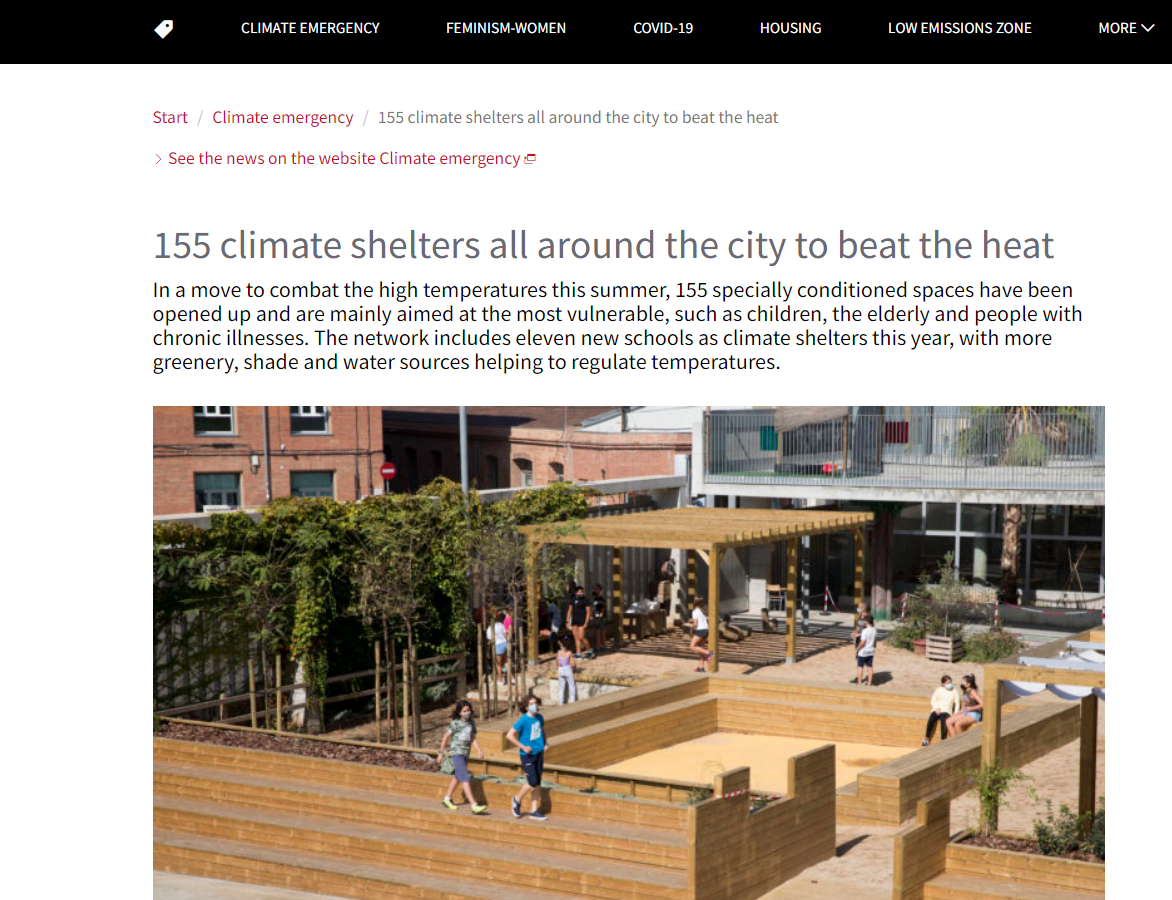
It is important to note that the coordination of the Climate Shelters project during its upscaling phase (see also the Upscaling section of this Journal) has been assigned to CEB, an entity with the responsibility to tailor the educational needs of all schools in the city and one of the main partner entities of the Climate Shelters project.
Public procurement
Despite the covid-19 pandemic, the project managed to implement on time all schools’ technical solutions (see Figure 2 as example). This has been a considerable achievement owing to a stepwise process as follows:
(a) the preparation of a thorough analysis of the schools (titled “Adapting schools to climate change by means of green, blue and grey interventions” and prepared by the Agencia d’ Energia de Barcelona with the support of the Societat Organica),
(b) the co-creative participatory process of the project with the school community towards the selection of the final solutions per school,
(c) the preparation of a detailed document for every school including a guide for the green, blue and grey solutions to be implemented,
(d) the completion, under the supervision of CEB, of the construction works for the conversion of schools to Climate Shelters (12 schools by October 2020 and 12 more by September 2021, the latter in the upscaling phase of the project),
(f) refinement and correction of the technical works to the extent needed.
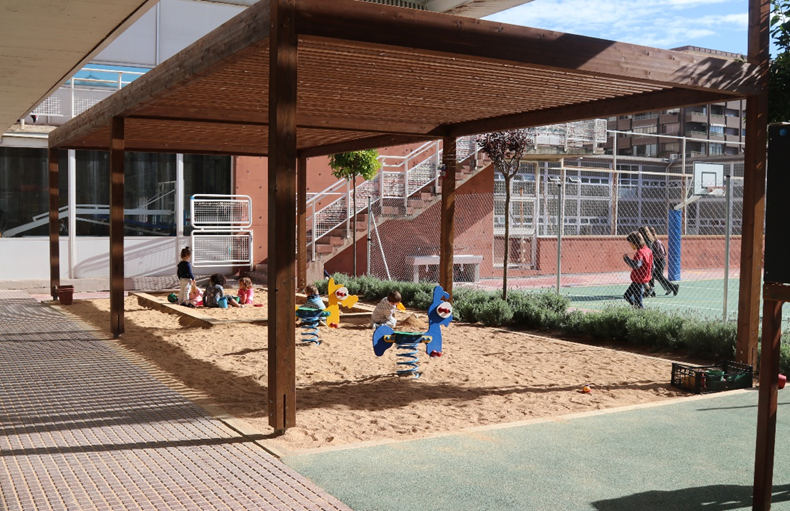
Figure 2. Characteristic example of a technical solution (Itaca school).
Upon conclusion of the interventions in each of the Climate Shelters schools, an assessment of their performance was worked out in close communication with the teachers and the students.
As an example, during a visit to schools of the project (25.11.2021), the teachers at the Poblenou school expressed their satisfaction for the technical solutions applied through the Climate Shelters project, especially the ones that provided controlled shade to the façade of the school and also resulted in new “indoor-outdoor” spaces to be developed (see Figure 3).
Similarly, the teachers from the Villa Olimpica school referred to the benefits of the technical solutions for the ventilation of the classrooms and the resulting indoor temperature control as well as for the potential developed for additional outdoor activities as facilitated by a new pergola (Figure 4).
Finally, the teachers at the Cervantes school, referred to a better school environment, considerably more friendly for the school community; they also mentioned, a positive change in the socializing patterns of the students.
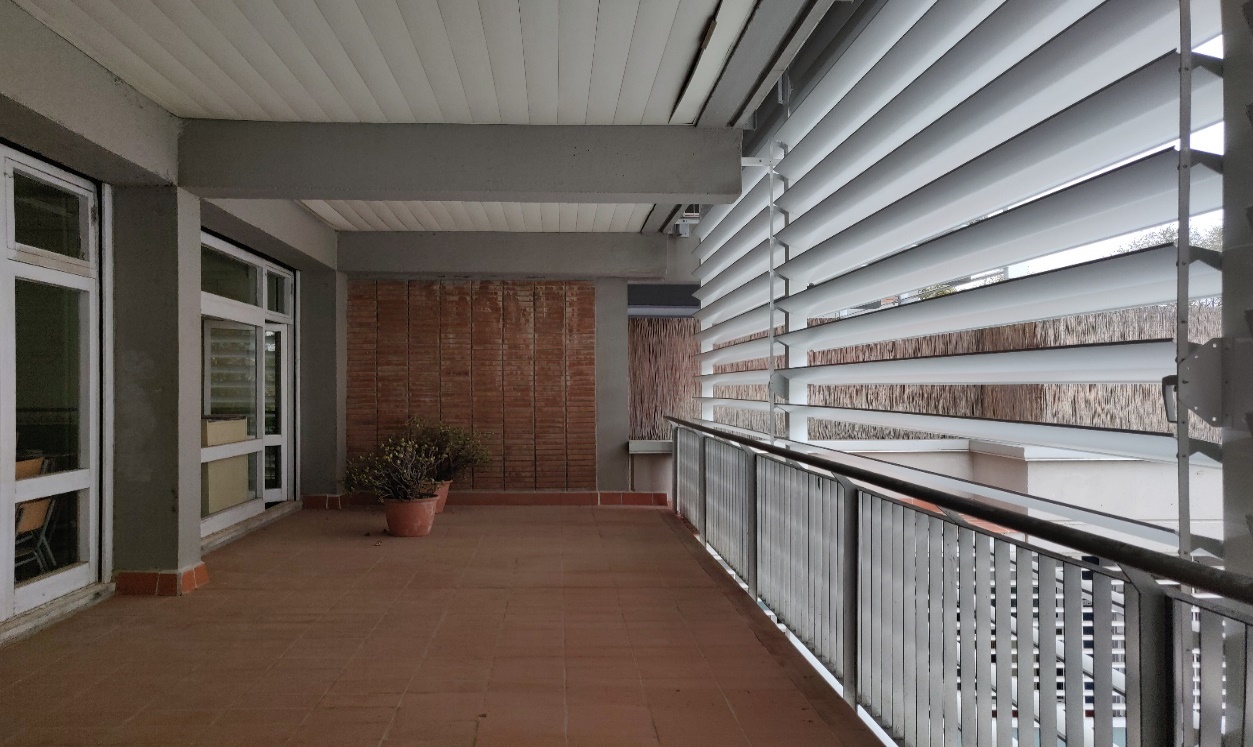
Figure 3. Shading device at the façade of the Poblenou school, also leading to a new working space for the school.
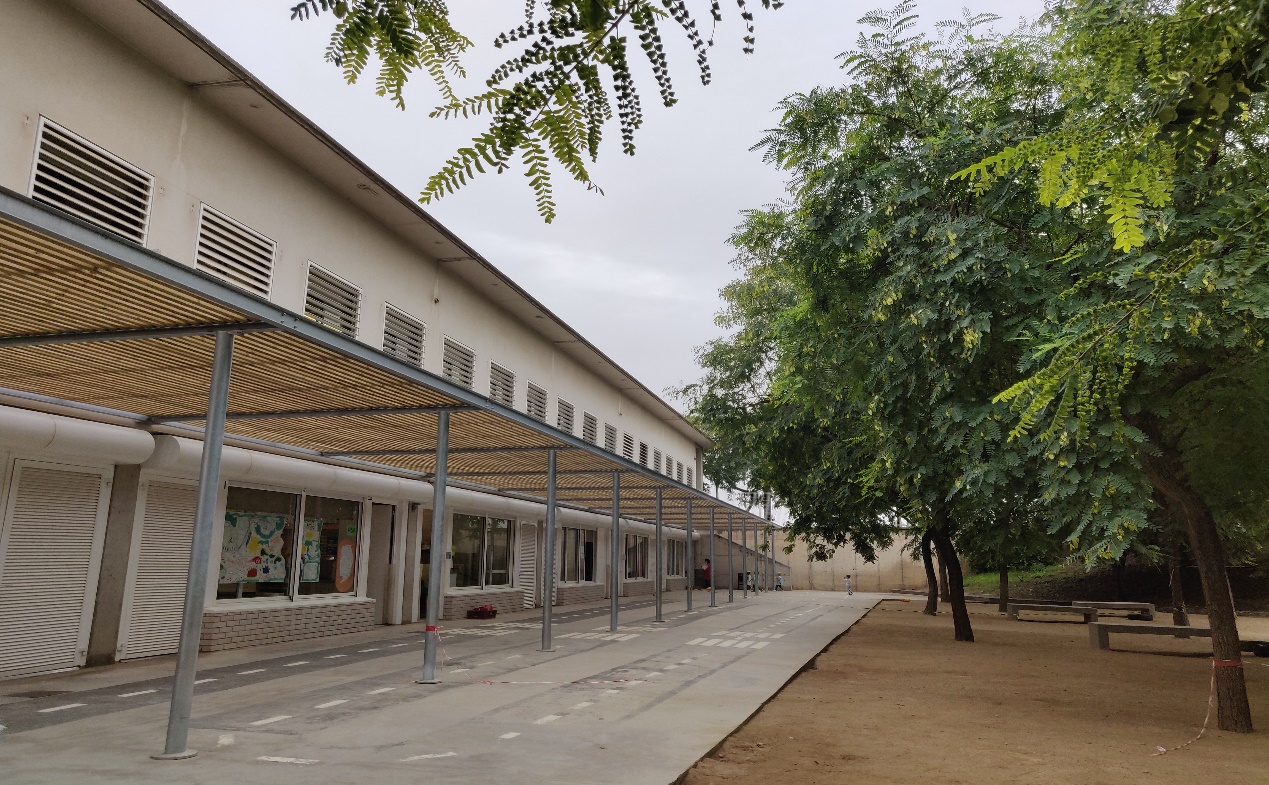
Figure 4. Shading in all classrooms’ windows at the Villa Olimpica school has improved indoor temperature conditions and facilitated improved ventilation patterns.
An issue of consideration is that blue solutions reflecting high maintenance costs or (potentially) water quality issues were not implemented.
A potential risk in projects with strong technical dimension is the maintenance of the technical solutions, once in operational use. Progress in this area is recognized, as CEB has undertaken the respective responsibility and has secured the needed annual funding.
Organizational arrangements within the urban authority (cross departmental working)
The Climate Shelters project reached a high level of cross-departmental collaboration and working within the City of Barcelona. A considerable gain was the complementarity of the Climate Shelters project to other city projects, for instance the one on Open School Yards. The latest allows the use of school yards by city dwellers, one of the main priorities of the Climate Shelters Project.
The organizational arrangements within the City Council of Barcelona supported the interplay of the educational, pedagogical, scientific and technical aspects of the project, whereas the delegation of authority to the working groups and the employment of iterative processes among partners, stakeholders and experts for solution solving and decision making, were proven beneficial for the progress of the project. The organizational arrangements promoted during the Climate Shelters project reflect a legacy for the City Council of Barcelona.
Participative approach for co-implementation
The participative approach for co-implementation as applied within the Climate Shelters project, can be clearly considered as one of the strongest elements of the project. From the early stages of the project, a well-designed, coordinated and executed plan was promoted giving space to teachers, students, parents and residents of the schools’ areas, to provide their views and proposals, assess the suggested - by experts and city officials - solutions and interventions and at the end co-create the final set of solutions to be implemented in each school.
At present stage, all four participatory sessions of the project are concluded. At the completion of the 4th session, focused meetings took place in each of the Climate Shelters schools with the participation of teachers and students. Impressions and comments were collected for further analysis, whereas refinement measures were noted and implemented to the extent possible.
The participative approach of the Climate Shelters project reflects an excellent showcase of urban governance with and for the citizens: decision-making as close as possible to the citizen, open deliberations and finally co-creation of solutions.
Monitoring and evaluation
The ongoing evaluation, by the Barcelona Institute for Global Health (ISGlobal), the Institute of Environment Science and Technology (ICTA-UAB) and the Public Health Agency of Barcelona (ASPB), of the impacts of the blue, green and grey interventions to the 11 schools is not exhausted to the analysis of air quality and temperature data; it also focus on:
(a) developed dynamics in the playground in terms of the diversification of play possibilities and socializing patterns and
(b) health, well-being and physical activity of the users.
Specific objectives of the monitoring and evaluation plan are:
- To monitor the performance of the project with the use of a set of indicators as developed particularly for the Climate Shelters project,
- To monitor the state of indoor and outdoor air quality in the Climate Shelters schools,
- To evaluate – on the basis of the data monitored - the impact of the interventions on students in terms of health, well-being, physical activity and awareness, attitudes and perceptions towards the environment,
- To evaluate the impact of the interventions onto the school’s indoor and outdoor environmental conditions and
- To evaluate the use of the open playgrounds by the local community.
In the course of the project, results indicators were defined for eight distinct sectors of the Climate Shelters project (Figure 5) in order to periodically assess the performance of the project:
- Adaptation to climate change
- Healthy, playful and inclusive schools
- Climate justice
- Coherent community
- Conscientious and responsible citizens for Climate Change
- Efficient and sustainable city
- Upscaling of the project
- Replication potential
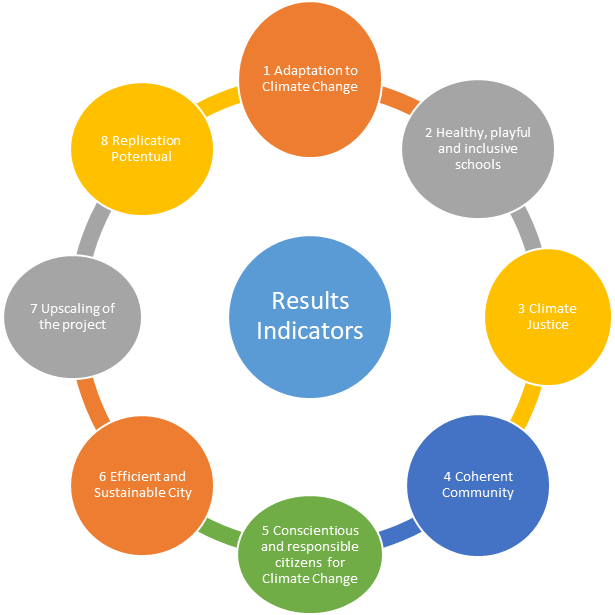
Figure 5. An illustration of the Results Indicators.
As per the ambient environment and air quality in particular, the ongoing evaluation refers to the analysis and cross correlation of such indoor and outdoor environmental measurements as temperature, humidity, Particulate Matter (PM), carbon dioxide, ozone and nitrogen dioxide (see Figure 6 on the measurements’ planning). It should be mentioned that low cost commercial sensors as well precision scientific instrumentation were installed at the schools to support the monitoring needs (for more information see Journal 2 of the project).
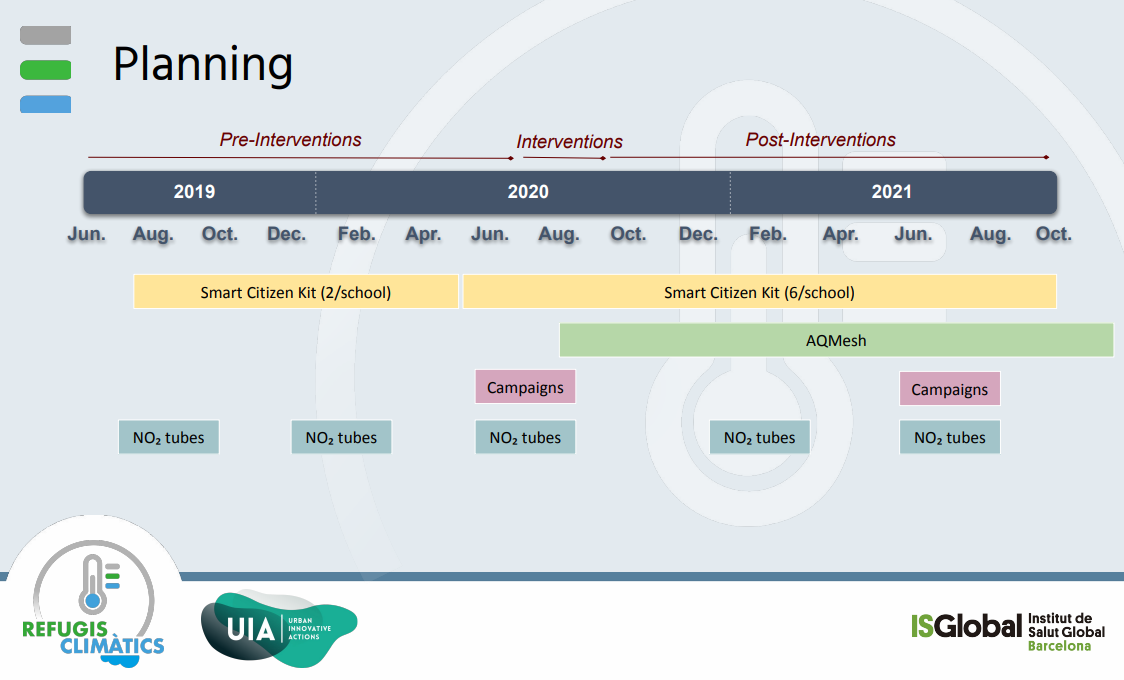
Figure 6. Planning for the outdoor and indoor measurements during the pre-interventions, interventions and post-interventions periods.
For the evaluation of the environmental measurements, the applied methodology consists of five steps: (a) Data collection; (b) Quantification of the available data; (c) Filtering and data cleaning; (d) Data validation and correction and (e) Data analysis.
A pending challenge of the project in the period following its conclusion, is to develop, populate and sustain a data repository. The decisions on the above challenge as well as for the definition of the respective entity for its development and maintenance, are pending.
Communication and evaluation
The project gave considerable weight to communication in order to pass the message that Climate Shelters can be supportive for the adaptation of Barcelona to climate change. The communication plan included:
- updating of the project website and links to other city projects,
- communication of the project in municipal newsletters (OBRA: Observatori rehabilitació, Escoles + Sostenibles, Districts),
- monitoring the work and activities in schools and promotion of this material to social media networks and the internet,
- school transformation communication,
- promotion of the project by the schools (banners in schools, news and social networks, leaflets, roll-ups),
In support of the communication objectives of the project, several videos were prepared to demonstrate the project’s methodology and results:
The video at https://www.youtube.com/watch?v=pt3ymwVRPlQ describes the project overall and presents the views of teachers and students regarding the final results.
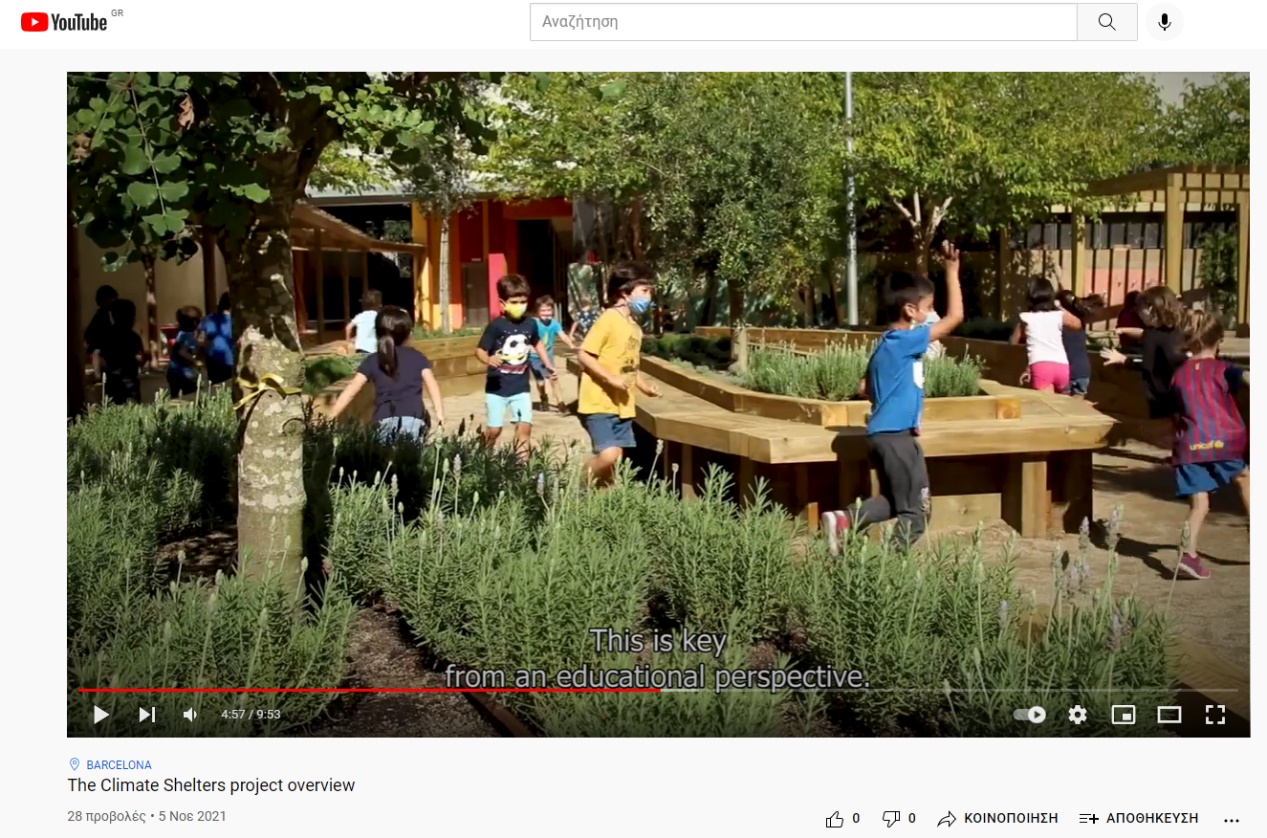
The vídeo https://www.youtube.com/watch?v=ZI8cLMQaukU, presents the main steps, the results and the upscaling prospects of the Climate Shelters project.
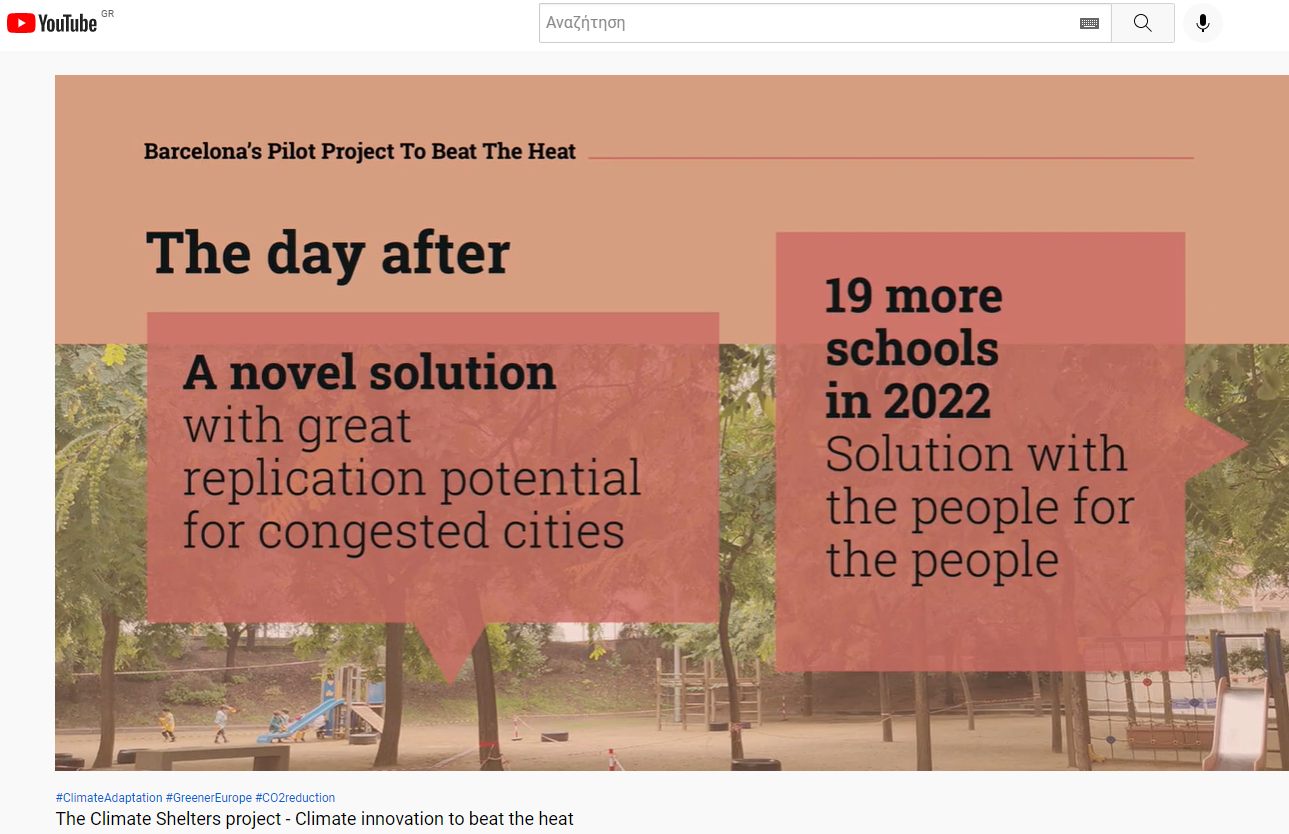
A video https://youtube/J3jQHQMUkMc on the pedagogical approach of the Climate Shelters project has been also prepared and disseminated; the video is enriched with colorful drawings and animation and presents the pedagogical material collected in learning suitcases and provided to the pilot schools to continue their educational projects on Climate Change Adaptation.

Videos regarding the implementation of the Climate Shelters project to each participating school were also prepared; in these videos, a snapshot of the technical solutions applied in each school is provided, whereas teachers and students are given the opportunity to express their views on the project as applied to their own school (Figure 7).
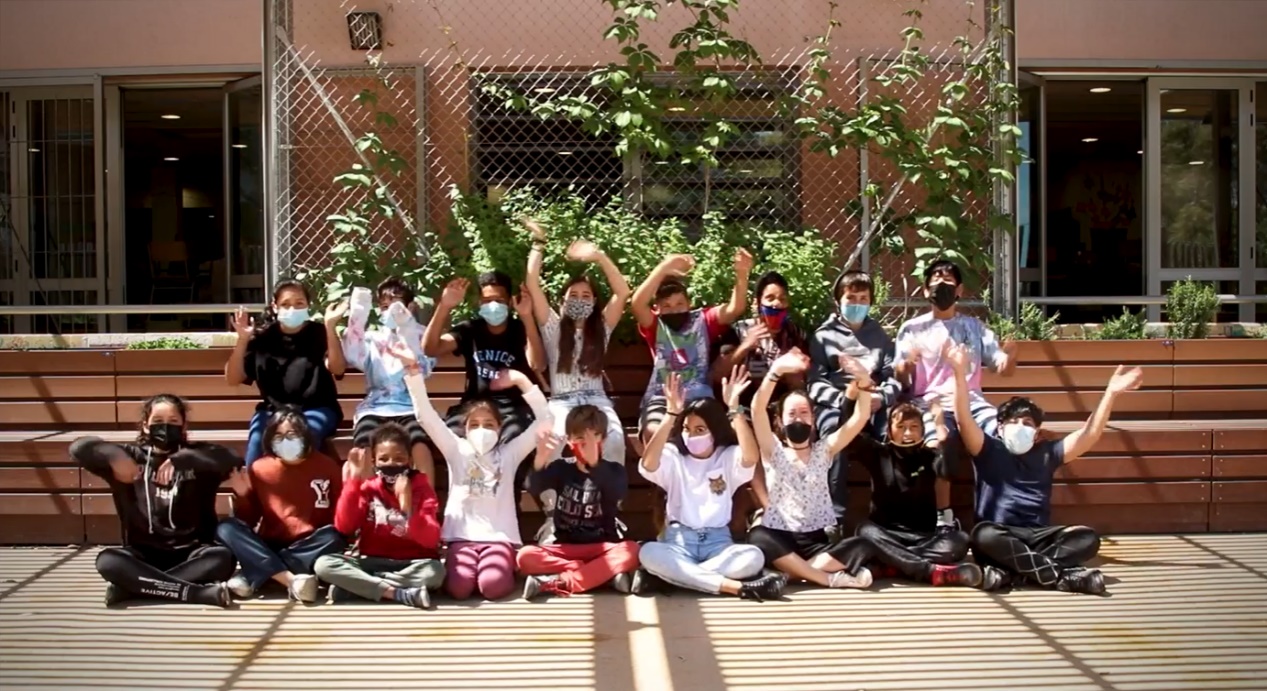
Figure 7. Snapshot from the video for the Climate Shelter at the Antaviana school.
Finally, in 21/10/2021, at the Espai Jove la Fontana, the new pedagogical suitcases were delivered to the 21 schools in the city involved in the project "Adapting schools to climate change through green, blue and gray" in recognition of their participation and effort”. The project, has served as a platform for the production of various pedagogical materials on the climate emergency, such as the guide for teachers “The challenge of the climate emergency. Informative guide and proposal of educational activities”, and the “Pedagogical suitcase to face the climatic emergency”.
Upscaling
The City of Barcelona has decided to continue the Climate Shelters project, although as not a stand-alone project but rather as an integral part of a wider program named “Let’s transform the school yards”. This program aims, on the basis of criteria for a good playground as well as the criteria related to the UIA pilot project of Climate Shelters, to transform a minimum of 10 schoolyards each year in three aspects:
- the physical spaces to become Climate Shelters and therefore greener, naturalized and shaded;
- the dynamics and life experiences of children in the playground to foster more relationships through the diversification of education, sport and play possibilities and activities; and
- the local community uses the school yards as neighborhood facilities.
In terms of the physical transformation of the spaces, the co-creation participatory process as applied during the Climate Shelters project is replicated, in order for the school community (teachers, pupils and parents) as well as the residents in the neighborhood to express their needs and suggestions and contribute to the selection of the technical solutions.
Positive elements of the integration of the Climate Shelters project to the “Let’s transform the school yards” Program of the City of Barcelona are:
(a) the sustainability of the Climate Shelters project,
(b) the inclusive character of the Program as the calls are open to all schools (with the exception of the schools of Round 2 as there were selected from the forty five ones which had initially expressed interest to the Climate Shelters project),
(c) the perseverance of the main philosophy of the Climate Shelters project, namely emphasis to the selection of technical solutions for climate change adaptation at the school level, to participatory processes of co-creation with the educational communities at large (pupils, teachers and families) and to strong educational and pedagogical orientation,
(d) a multiple range of selection criteria: environmental (for instance located in areas with lower urban greenery), socioeconomic, infrastructural and educational,
(e) the allocated annual funding of around 3 million euros and
(f) the implementation of the program through a partnership between the Barcelona City Council (the Municipal Education Council of Barcelona - CEMB) and CEB, with the collaboration of the Institut Infància i Adolescència de Barcelona and the Rosa Sensat Teachers Association. The latter has undertaken the part of open debates in all schools, the exchange of experiences and pedagogical orientations to promote the best potential.
Pending issues to be dealt, refer to the expansion of the catalogue of potential solutions to include photovoltaic installations and a wider range of blue measures, whereas a strong recommendation is to give more emphasis to energy related solutions.
In addition, it is important to preserve the pertinent pillars of monitoring and evaluation as applied in the Climate Shelters project, namely air quality monitoring, the assessment of the project’s performance against indicators and the evaluation of the impact of the transformations to environment, well-being and health.
The project has taken good note of the need for the early scheduling of the upscaling process and has already deployed the upscaling plan in two rounds (June 2021 and June 2022). To this end, a strong legacy of the Climate Shelters project has been realized, while preserving to a good extent the authenticity of the innovative UIA project.
In general terms, a strong message from the implementation of the Climate Shelters project by the City of Barcelona is that upscaling plans need to be worked out early enough before the completion of a project.
Leadership
Τhe project has enjoyed strong political support by the Mayor of Barcelona, from its inception and throughout all of its phases. This is an important aspect not only for the timely implementation of the project but also for its sustainability, for instance through its integration to the overall climate policy of Barcelona.
Furthermore, the project is coordinated in its upscaling phase by the Barcelona Consortium of Education (CEB), namely an experienced entity of the City of Barcelona, with the support of a team of experts, with strong complementarities with respect to their specialization and capacities. Continuity in the overall coordination structure is proven beneficial for the progress of the project.
An issue deserving special consideration is that the Climate Shelters project took advantage of the early preparedness of the City of Barcelona with respect to climate change adaptation. In practical terms, the urban ecology program of the City of Barcelona paved the way to the definition of the climate priorities and subsequently to the development of Barcelona’s climate plan. The latter has acted as the framework for the integration of the Climate Shelters project to the overall climate plan of Barcelona.
The integration of the Climate Shelters project to the overall climate plan of the City of Barcelona is demonstrated in the announcement of the City of Barcelona, regarding the network of 155 specially conditioned spaces that have opened up during a last summer heat wave; the network also included the eleven schools which were converted to Climate Shelters through the UIA project.

It is important to note that the coordination of the Climate Shelters project during its upscaling phase (see also the Upscaling section of this Journal) has been assigned to CEB, an entity with the responsibility to tailor the educational needs of all schools in the city and one of the main partner entities of the Climate Shelters project.
Public procurement
Despite the covid-19 pandemic, the project managed to implement on time all schools’ technical solutions (see Figure 2 as example). This has been a considerable achievement owing to a stepwise process as follows:
(a) the preparation of a thorough analysis of the schools (titled “Adapting schools to climate change by means of green, blue and grey interventions” and prepared by the Agencia d’ Energia de Barcelona with the support of the Societat Organica),
(b) the co-creative participatory process of the project with the school community towards the selection of the final solutions per school,
(c) the preparation of a detailed document for every school including a guide for the green, blue and grey solutions to be implemented,
(d) the completion, under the supervision of CEB, of the construction works for the conversion of schools to Climate Shelters (12 schools by October 2020 and 12 more by September 2021, the latter in the upscaling phase of the project),
(f) refinement and correction of the technical works to the extent needed.

Figure 2. Characteristic example of a technical solution (Itaca school).
Upon conclusion of the interventions in each of the Climate Shelters schools, an assessment of their performance was worked out in close communication with the teachers and the students.
As an example, during a visit to schools of the project (25.11.2021), the teachers at the Poblenou school expressed their satisfaction for the technical solutions applied through the Climate Shelters project, especially the ones that provided controlled shade to the façade of the school and also resulted in new “indoor-outdoor” spaces to be developed (see Figure 3).
Similarly, the teachers from the Villa Olimpica school referred to the benefits of the technical solutions for the ventilation of the classrooms and the resulting indoor temperature control as well as for the potential developed for additional outdoor activities as facilitated by a new pergola (Figure 4).
Finally, the teachers at the Cervantes school, referred to a better school environment, considerably more friendly for the school community; they also mentioned, a positive change in the socializing patterns of the students.

Figure 3. Shading device at the façade of the Poblenou school, also leading to a new working space for the school.

Figure 4. Shading in all classrooms’ windows at the Villa Olimpica school has improved indoor temperature conditions and facilitated improved ventilation patterns.
An issue of consideration is that blue solutions reflecting high maintenance costs or (potentially) water quality issues were not implemented.
A potential risk in projects with strong technical dimension is the maintenance of the technical solutions, once in operational use. Progress in this area is recognized, as CEB has undertaken the respective responsibility and has secured the needed annual funding.
Organizational arrangements within the urban authority (cross departmental working)
The Climate Shelters project reached a high level of cross-departmental collaboration and working within the City of Barcelona. A considerable gain was the complementarity of the Climate Shelters project to other city projects, for instance the one on Open School Yards. The latest allows the use of school yards by city dwellers, one of the main priorities of the Climate Shelters Project.
The organizational arrangements within the City Council of Barcelona supported the interplay of the educational, pedagogical, scientific and technical aspects of the project, whereas the delegation of authority to the working groups and the employment of iterative processes among partners, stakeholders and experts for solution solving and decision making, were proven beneficial for the progress of the project. The organizational arrangements promoted during the Climate Shelters project reflect a legacy for the City Council of Barcelona.
Participative approach for co-implementation
The participative approach for co-implementation as applied within the Climate Shelters project, can be clearly considered as one of the strongest elements of the project. From the early stages of the project, a well-designed, coordinated and executed plan was promoted giving space to teachers, students, parents and residents of the schools’ areas, to provide their views and proposals, assess the suggested - by experts and city officials - solutions and interventions and at the end co-create the final set of solutions to be implemented in each school.
At present stage, all four participatory sessions of the project are concluded. At the completion of the 4th session, focused meetings took place in each of the Climate Shelters schools with the participation of teachers and students. Impressions and comments were collected for further analysis, whereas refinement measures were noted and implemented to the extent possible.
The participative approach of the Climate Shelters project reflects an excellent showcase of urban governance with and for the citizens: decision-making as close as possible to the citizen, open deliberations and finally co-creation of solutions.
Monitoring and evaluation
The ongoing evaluation, by the Barcelona Institute for Global Health (ISGlobal), the Institute of Environment Science and Technology (ICTA-UAB) and the Public Health Agency of Barcelona (ASPB), of the impacts of the blue, green and grey interventions to the 11 schools is not exhausted to the analysis of air quality and temperature data; it also focus on:
(a) developed dynamics in the playground in terms of the diversification of play possibilities and socializing patterns and
(b) health, well-being and physical activity of the users.
Specific objectives of the monitoring and evaluation plan are:
- To monitor the performance of the project with the use of a set of indicators as developed particularly for the Climate Shelters project,
- To monitor the state of indoor and outdoor air quality in the Climate Shelters schools,
- To evaluate – on the basis of the data monitored - the impact of the interventions on students in terms of health, well-being, physical activity and awareness, attitudes and perceptions towards the environment,
- To evaluate the impact of the interventions onto the school’s indoor and outdoor environmental conditions and
- To evaluate the use of the open playgrounds by the local community.
In the course of the project, results indicators were defined for eight distinct sectors of the Climate Shelters project (Figure 5) in order to periodically assess the performance of the project:
- Adaptation to climate change
- Healthy, playful and inclusive schools
- Climate justice
- Coherent community
- Conscientious and responsible citizens for Climate Change
- Efficient and sustainable city
- Upscaling of the project
- Replication potential

Figure 5. An illustration of the Results Indicators.
As per the ambient environment and air quality in particular, the ongoing evaluation refers to the analysis and cross correlation of such indoor and outdoor environmental measurements as temperature, humidity, Particulate Matter (PM), carbon dioxide, ozone and nitrogen dioxide (see Figure 6 on the measurements’ planning). It should be mentioned that low cost commercial sensors as well precision scientific instrumentation were installed at the schools to support the monitoring needs (for more information see Journal 2 of the project).

Figure 6. Planning for the outdoor and indoor measurements during the pre-interventions, interventions and post-interventions periods.
For the evaluation of the environmental measurements, the applied methodology consists of five steps: (a) Data collection; (b) Quantification of the available data; (c) Filtering and data cleaning; (d) Data validation and correction and (e) Data analysis.
A pending challenge of the project in the period following its conclusion, is to develop, populate and sustain a data repository. The decisions on the above challenge as well as for the definition of the respective entity for its development and maintenance, are pending.
Communication and evaluation
The project gave considerable weight to communication in order to pass the message that Climate Shelters can be supportive for the adaptation of Barcelona to climate change. The communication plan included:
- updating of the project website and links to other city projects,
- communication of the project in municipal newsletters (OBRA: Observatori rehabilitació, Escoles + Sostenibles, Districts),
- monitoring the work and activities in schools and promotion of this material to social media networks and the internet,
- school transformation communication,
- promotion of the project by the schools (banners in schools, news and social networks, leaflets, roll-ups),
In support of the communication objectives of the project, several videos were prepared to demonstrate the project’s methodology and results:
The video at https://www.youtube.com/watch?v=pt3ymwVRPlQ describes the project overall and presents the views of teachers and students regarding the final results.

The vídeo https://www.youtube.com/watch?v=ZI8cLMQaukU, presents the main steps, the results and the upscaling prospects of the Climate Shelters project.

A video https://youtube/J3jQHQMUkMc on the pedagogical approach of the Climate Shelters project has been also prepared and disseminated; the video is enriched with colorful drawings and animation and presents the pedagogical material collected in learning suitcases and provided to the pilot schools to continue their educational projects on Climate Change Adaptation.

Videos regarding the implementation of the Climate Shelters project to each participating school were also prepared; in these videos, a snapshot of the technical solutions applied in each school is provided, whereas teachers and students are given the opportunity to express their views on the project as applied to their own school (Figure 7).

Figure 7. Snapshot from the video for the Climate Shelter at the Antaviana school.
Finally, in 21/10/2021, at the Espai Jove la Fontana, the new pedagogical suitcases were delivered to the 21 schools in the city involved in the project "Adapting schools to climate change through green, blue and gray" in recognition of their participation and effort”. The project, has served as a platform for the production of various pedagogical materials on the climate emergency, such as the guide for teachers “The challenge of the climate emergency. Informative guide and proposal of educational activities”, and the “Pedagogical suitcase to face the climatic emergency”.
Upscaling
The City of Barcelona has decided to continue the Climate Shelters project, although as not a stand-alone project but rather as an integral part of a wider program named “Let’s transform the school yards”. This program aims, on the basis of criteria for a good playground as well as the criteria related to the UIA pilot project of Climate Shelters, to transform a minimum of 10 schoolyards each year in three aspects:
- the physical spaces to become Climate Shelters and therefore greener, naturalized and shaded;
- the dynamics and life experiences of children in the playground to foster more relationships through the diversification of education, sport and play possibilities and activities; and
- the local community uses the school yards as neighborhood facilities.
In terms of the physical transformation of the spaces, the co-creation participatory process as applied during the Climate Shelters project is replicated, in order for the school community (teachers, pupils and parents) as well as the residents in the neighborhood to express their needs and suggestions and contribute to the selection of the technical solutions.
Positive elements of the integration of the Climate Shelters project to the “Let’s transform the school yards” Program of the City of Barcelona are:
(a) the sustainability of the Climate Shelters project,
(b) the inclusive character of the Program as the calls are open to all schools (with the exception of the schools of Round 2 as there were selected from the forty five ones which had initially expressed interest to the Climate Shelters project),
(c) the perseverance of the main philosophy of the Climate Shelters project, namely emphasis to the selection of technical solutions for climate change adaptation at the school level, to participatory processes of co-creation with the educational communities at large (pupils, teachers and families) and to strong educational and pedagogical orientation,
(d) a multiple range of selection criteria: environmental (for instance located in areas with lower urban greenery), socioeconomic, infrastructural and educational,
(e) the allocated annual funding of around 3 million euros and
(f) the implementation of the program through a partnership between the Barcelona City Council (the Municipal Education Council of Barcelona - CEMB) and CEB, with the collaboration of the Institut Infància i Adolescència de Barcelona and the Rosa Sensat Teachers Association. The latter has undertaken the part of open debates in all schools, the exchange of experiences and pedagogical orientations to promote the best potential.
Pending issues to be dealt, refer to the expansion of the catalogue of potential solutions to include photovoltaic installations and a wider range of blue measures, whereas a strong recommendation is to give more emphasis to energy related solutions.
In addition, it is important to preserve the pertinent pillars of monitoring and evaluation as applied in the Climate Shelters project, namely air quality monitoring, the assessment of the project’s performance against indicators and the evaluation of the impact of the transformations to environment, well-being and health.
The project has taken good note of the need for the early scheduling of the upscaling process and has already deployed the upscaling plan in two rounds (June 2021 and June 2022). To this end, a strong legacy of the Climate Shelters project has been realized, while preserving to a good extent the authenticity of the innovative UIA project.
In general terms, a strong message from the implementation of the Climate Shelters project by the City of Barcelona is that upscaling plans need to be worked out early enough before the completion of a project.
5. Summing up the main aspects
The project has concluded with success a critical phase, namely the transformation of schools to Climate Shelters and their operation. In practical terms, it has developed a solid multi-step methodology regarding the selection process of the schools, the scientific criteria for the assessment of their environmental and climate state, the development of catalogs for the green, blue and grey measures and the co-creation participative approach for the selection of the mix of technical solutions per school.
The project has also continued the implementation of a multi-dimensional communication plan with solid results, despite the cancelation of social events and public meetings due to the covid-19 pandemic. To circumvent the covid-19 related difficulties, more emphasis was given to the preparation of videos on the project and its results as well as to the use of social media.
In its upscaling phase, the Climate Shelters project was integrated in the “Let’s transform the school yards” program, a fact which supports its sustainability over the next years. Ten more schools were transformed to Climate Shelters in the year 2021 and ten more will be transformed in 2022.
The evaluation of the impact of the project to the environment, well-being and health is undergoing, with the preliminary results indicating improvements at the school level. Effort should be made to retain the evaluation and monitor processes of the Climate Shelters project, also in its upscaling phase.
Finally, the next steps of the project are: (a) the completion of the evaluation plan in order to assess the impact of the project to the environment, well-being and health of the Climate Shelter schools (b) the promotion of a communication plan in order to convey the results of the project to local communities (c) the continuation of the upscaling process in support of the project’s replication and (d) the implementation of the co-creating participatory processes for the new schools joining the project.
References
1 https://www.uia-initiative.eu/en/about-us/what-urban-innovative-actions
2 https://www.uia-initiative.eu/en/uia-cities/barcelona-call3
3 Barcelona Consortium of Education (CEB), is a Municipal entity taken having, among others, the responsibility for the construction of public schools as well as for their annual maintenance. It belongs to the Regional Government of Catalonia (60%) and to the City Council of Barcelona (40%)
6 https://uia-initiative.eu/en/news/climate-shelters-journal-2-update-barcelonas-project
The project has concluded with success a critical phase, namely the transformation of schools to Climate Shelters and their operation. In practical terms, it has developed a solid multi-step methodology regarding the selection process of the schools, the scientific criteria for the assessment of their environmental and climate state, the development of catalogs for the green, blue and grey measures and the co-creation participative approach for the selection of the mix of technical solutions per school.
The project has also continued the implementation of a multi-dimensional communication plan with solid results, despite the cancelation of social events and public meetings due to the covid-19 pandemic. To circumvent the covid-19 related difficulties, more emphasis was given to the preparation of videos on the project and its results as well as to the use of social media.
In its upscaling phase, the Climate Shelters project was integrated in the “Let’s transform the school yards” program, a fact which supports its sustainability over the next years. Ten more schools were transformed to Climate Shelters in the year 2021 and ten more will be transformed in 2022.
The evaluation of the impact of the project to the environment, well-being and health is undergoing, with the preliminary results indicating improvements at the school level. Effort should be made to retain the evaluation and monitor processes of the Climate Shelters project, also in its upscaling phase.
Finally, the next steps of the project are: (a) the completion of the evaluation plan in order to assess the impact of the project to the environment, well-being and health of the Climate Shelter schools (b) the promotion of a communication plan in order to convey the results of the project to local communities (c) the continuation of the upscaling process in support of the project’s replication and (d) the implementation of the co-creating participatory processes for the new schools joining the project.
References
1 https://www.uia-initiative.eu/en/about-us/what-urban-innovative-actions
2 https://www.uia-initiative.eu/en/uia-cities/barcelona-call3
3 Barcelona Consortium of Education (CEB), is a Municipal entity taken having, among others, the responsibility for the construction of public schools as well as for their annual maintenance. It belongs to the Regional Government of Catalonia (60%) and to the City Council of Barcelona (40%)
6 https://uia-initiative.eu/en/news/climate-shelters-journal-2-update-barcelonas-project
About this resource
The Urban Innovative Actions (UIA) is a European Union initiative that provided funding to urban areas across Europe to test new and unproven solutions to urban challenges. The initiative had a total ERDF budget of €372 million for 2014-2020.
Similar content




